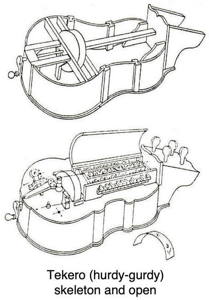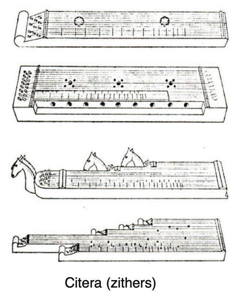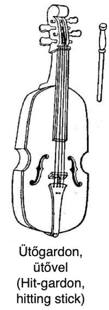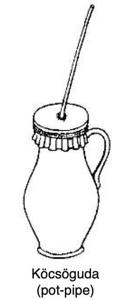
|
Folk Dance Federation of California, South, Inc.
Hungarian Folk Bands |
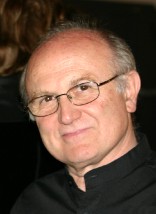
|
CLICK AN IMAGE TO ENLARGE
For many years we have grown accustomed to the "big band" Romani orchestra sound in Hungarian folk music while wishing for something more exciting. Because of the ever increasing popularity of the young, handsome, and romantic Romani "primás" (band leaders), Hungarian folk music was almost lost and forgotten in latter years in Hungary and worldwide (such as in Hollywood). Thanks to a group of young musicians, Hungarian folk music is being revitalized in Hungary, and as a result, it can once again be presented in its authentic form.
Of course, the romantic Romani "primás" has not disappeared and put back in his proper place. His music has never been that of the folk. Although he based his material on folk motifs, he was fast to change it to suit the taste of the society around him. He played mostly for the middle and upper classes in city café houses – seldom for the folk in a country setting. His music may be classed as 18th- and 19th-century romantic "folklike" music that was popular for many decades – well into the 20th century in Hungary.
On the other hand, let us now examine what the authentic folk orchestra, existing simultaneously with the Romani bands of the city, looked and sounded like in a village somewhere in Hungary.
First, we must recognize that a village folk orchestra, in almost all cases, consists of but a few musicians – three of four at the most. Therefore, sound will be that of a small "combo" group. Also, it is important to remember that the musicians in this type of band are not trained virtuosi. They play well, however, in their characteristic regional style, because they practiced it all of their lives. Secondly, we should understand that there were many villages and farmsteads where folk bands never existed – only a couple of peasants, with special instruments, usually made by themselves – who would entertain guests at weddings and other festive occasions. These musical instruments were designed to give a "drone" (constantly heard) sound to the melody, thus serving as substitutes for the sophisticated instruments of a regular band.
In the following, only a few of the possibilities for a Hungarian folk band will be discussed and some of the special folk instruments will be described.
Full-Size Romani Band
This band consists of four or more musicians. The "primás," who is the leader, plays the violin. A viola (brácsa), a double-bass, and usually a cymbalom are accompanying sounds. The components of this band are basically the same as those of a "big-band" Romani orchestra. The cymbalom (the Hungarian version of an oversized hammered dulcimer) is the most exciting of them. It is often used as a solo instrument as well, and its playing requires great virtuosity.
Mezöségi Malac Band
Mezöség is a regijon of Transylvania approximately northeast of Kolozsvár (Cluj). Almost all of its villages are Hungarian and extremely rich in folklore. the music is also very characteristic. A band from this area usually has three musicians: the "primás" on the violin, the "brácsa" (three-stringed viola), and a "bőgő" (three-stringed bass). The reason for the three strings is that the bridge on the instruments is flattened so the player may use all three strings at the same time, thus delivering a sound that is larger and more full. The rhythmic accompaniment sometimes is more important than the melody. The "primás," however, is usually a virtuoso player of his regional music.
Csángó Folk Duo
The Csángós are Székely (Seckler) Hungarians living on the eastern slopes of the Carpathian Mountains in Romania. Their musical band always consists of two players – a violin and an ütőgardon (a cello-like stringed instrument that is not bowed but hit, producing a drum-line sound). The rhythmic pattern of Csángó music is highly versatile, reminiscent of Eastern rhythms.
Fúvós Zenekar
Fúvós zenekar (brass band) may be found in several places in the Hungarian-speaking areas. They vary greatly in size and in instrument composition. The use of these bands is limited to marches, processions at weddings, and at funerals.
Tárogató
Tárogató is one of the most unique of the Hungarian wind instruments. It has the mellow sound of a tenor saxophone, yet in appearance it resembles a primitive clarinet.
Citera Zenekar
Citera zenekar (zither band), the Hungarian zither, is the most widely used folk instrument in the country, even today. Several zither players gather around to play and sing their favorite songs; the öcsöguda (pot-pipe), or other primitive rhythmic instruments to give the beat to the music. The sound of a zither band might seem very strange at first, but once one gets used to it, the enjoyment is immense.
Tekerö
Tekerö (hurdy-gurdy) is usually a solo instrument because it produces a drone sound, a rhythmic pattern, and the melody as well. In some instances, however, other instruments may double up with it, for example, tárogató, drum, törösíp (zurna), violin, etc.
Miscellaneous
Hungarian folk music instruments may be: duda (babpipe), töröksíp (zurna), furulya (recorder or flute), nádsíp (reed), facimbalom (wooden cymbalom), doromb (jaw's harp) – just to name the best known ones. They are used solo or in ensembles.
Thus, you have some of the fascinating and varied possibilities for creating Hungarian folk music. Of course, many variations may occur from village to village, but from this description, it may be evident that not only the Romani band is typical to Hungarian folk music.
Excellent examples of these discussed Hungarian folk instruments and their combinations may be heard on numerous records listed, and available from record dealers in America.
- Argo ZFB – Folk Music from Hungary.
- Folkraft LP 40 – Folk Dances of Hungary.
- Folkraft LP 41 – Folk Dances of Transylvania.
- Folkraft LP 51 – Sebő Ensemble.
- Folkways FM 4000 – Folk Music of Hungary.
- Hungaria Records HRLP 001 – Kallós Zoltán's Transylvanian & Csángó Folk Music.
- Qualiton LPX 1187 – Hungarian Folk Music.
- Qualiton LPX 10095-8 – Hungarian Folk Music I.
- Qualiton LPX 18001-4 – Hungarian Folk Music II.
- Qualiton LPX 18019 – Hungarian Zither Music.
- Qualiton LPX 18033 – Táncház.
- Qualiton LPX 17482 – Sebő Ensemble.
Used with permission of the author.
Printed in Folk Dance Scene, February 1978.
